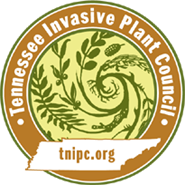Microstegium vimineum (Trin.) A. Camus
Japanese Stiltgrass, Nepalese Browntop, Nepalgrass| Threat Level | Category |
|---|---|
| Established | Grass |
|
Similar Species May be confused with the following native and/or non-native species. Landscape Alternatives lists native horticultural substitutes |
Leersia virginica Muhlenbergia schreberi Persicaria maculosa |
|---|

Description
Height
Microstegium is a sprawling, branched annual grass growing 6 to as much as 36 inches in height (15-90 cm). It often reclines on the ground with the tip turning upward.Stem
Stems are 59 inches (1.5 m) long, slender, and wiry, with smooth nodes (stem joints) and internodes (space between joints). Stems may be green to purple to brown and are covered by overlapping leaf sheaths.Leaves
There are no basal (ground) leaves. Stem leaves are alternate, lanceolate, 2-4 inches (5-10 cm) long, 0.08-0.6 inch (2-15 mm) wide, and project out from the stem. Blades are flat, sparsely hairy on both surfaces and along the margins. Midvein is silvery or whitish and off center. Throat collar (where blade and sheath meet around the stem) is hairy. The ligule (tissue found at this collar) is membranous with a hairy margin.Flowers
Flowering racemes are terminal and thin and may be solitary or in a set of two or three. Spikelets (individual flowers) are in pairs, inner one sessile (attached directly to main stem) and outer one pedicellate (on a short individual stem), and 0.17-0.2 inch (4.5-5mm) long. Blooms August-September.Seeds
The seed head is thin, and the grain is yellow to red, ellipsoid, 0.1-0.12 inch (2.8-3.0 mm) long. Seeds mature over a period of about two weeks in September-October or later. Seedstalks can remain into winter.Images
Photo: Chuck Bargeron, University of Georgia, Bugwood.orgMore images of Microstegium vimineum
Life History
Microstegium is an annual colonial grass in the Poaceae, Grass Family, that spreads rapidly into disturbed lowland areas. Inconspicuous at first, populations may go unnoticed until they have displaced native communities. It is a warm season, shade tolerant grass that can survive and reproduce under a closed forest canopy forming extensive infestations.It is colonial in nature, rooting from the nodes, and may form dense monotypic stands. Reproduction is exclusively from seed. Each plant may produce from 100-1,000 seeds that remain viable in the soil for five or more years. Seed dispersal is primarily by animals, flooding, and deposition with fill dirt. This plant spreads rapidly into disturbed areas but can invade undisturbed areas by forming satellite populations brought in by animals or flooding. On moist fertile sites, Japanese stiltgrass can replace competing ground vegetation within 3-5 years.
Microstegium is adapted to low light conditions. At 18% of full sunlight dry matter production is not significantly reduced from production in full sunlight. It will grow and produce seed in light levels as low as 5% of full sunlight. Spreads on trails and in recreational areas by seeds hitchhiking on hikers' and visitors' shoes and clothes.
Habitat
Alluvial soil found in flood plains and stream sides is ideal habitat for Microstegium, where is flourishes. Other typical habitats include damp fields, swamps, lawns, moist woodland edges, trailsides, roadsides, and ditches. It is commonly found in areas of natural (e.g., flood scouring) or artificial (e.g., mowing, tilling) disturbance, but can invade undisturbed areas. Japanese stiltgrass has been observed growing at an elevation of 3,840 feet (1,200 m), but typically is not found on upland sites. Deer avoid Microstegium, which allows it a competitive advantage in over browsed areas.Origin and Distribution
Microstegium is native to Japan, Korea, China, Malaysia, and India. It was first identified in the U.S. at Knoxville, Tennessee in 1919, and in 1933 was collected in western North Carolina. By 1964, the grass had spread to 35 counties in North Carolina. By 1972, it had been identified in 14 eastern states, and in 1978, it was collected in Arkansas. It can be found throughout the state of Tennessee, primarily in previously disturbed moist areas. Other states were invasive: IN, KY, GA, NC, VA, WV, MD, NJ, PA, NY, CT, MA, DE. Federal or state listed as noxious weed, prohibited, invasive or banned: AL, CT, MA.Sources: Information on this plant page derived primarily from the Tennessee Management Manual and James H. Miller's Nonnative Invasive Plants of Southern Forests, USDA Forest Service.
Management Recommendations
Mechanical Control
Mow plants as close to the ground as possible using a weedeater or similar grass cutting tool. Treatments should be made when plants are in flower and before seeds are produced. Treatments made earlier may result in plants producing new seed heads in the axils of lower leaves.Herbicidal Control
Herbicide treatments should be made late in the growing season but, before the plants set seed. Treatments made earlier in the growing season may allow a second cohort of plants to produce seeds.Glyphosate: Apply a 2% solution of glyphosate and water plus a 0.5% non-ionic surfactant to thoroughly wet all foliage. Do not spray to the point of runoff. Ambient air temperature should be above 65°F to ensure translocation of the herbicide to the roots. Do not apply if rainfall is expected within two hours following application.
Sethoxydin: Apply a 1.5% solution of sethoxydin and water plus a 1% nonphytotoxic vegetable-based oil to all foliage on a spray-to-wet basis. Do not spray to the point of runoff. Ambient air temperature should be above 65°F. Do not apply if rainfall is expected within one hour following application.
